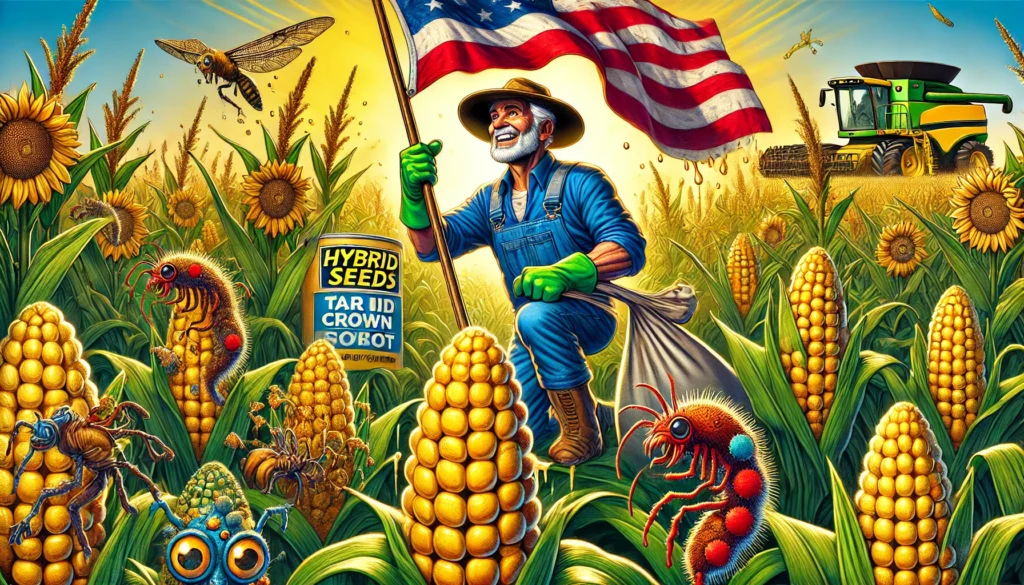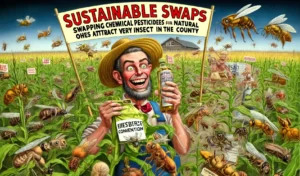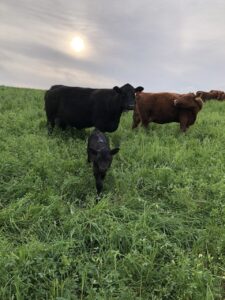
FarmerCowboy.com A closeup and detailed illustration capturing the triumph of American farmers during the 2024 harvest season. The focus Farming Alan Nafzger 4.webp.webp
Farmers vs. Pests 2024
A Battle for the Ages
By Grainy McLaughlin, Agriculture Satirist
Despite relentless attacks from an army of emerging pests, American farmers managed to break records for corn and soybean yields in 2024. From tar spot’s aggressive takeover to red crown rot’s sneaky expansion, farmers were stretched to their limits but fought back with strategies, technology, and sheer determination. Here’s a breakdown of how they triumphed in the year’s biggest agricultural battles.
Farmers Prove They Can Outwit Pests With Strategy and Fungicides
Pests underestimated the resourcefulness of American farmers. “You think a bug is going to scare me off? I once planted a field during a hailstorm,” said a grower from Indiana while holding a fungicide sprayer like a weapon.
Sales of fungicides hit record highs, with suppliers reporting a 30% increase over last year. “It’s like the farmers were ready for battle,” noted a distributor, who ran out of stock twice during the season.
Social media also became a battleground. A farmer from Iowa posted a video captioned, “Tar spot thinks it can win? Not on my watch,” as he sprayed fungicide to the tune of Eye of the Tiger.
Tar Spot Takes a Midwest Tour, But Farmers Fight Back
Tar spot’s march through 20 states and two Canadian provinces felt like the fungal version of a world tour. “It’s the Beyoncé of crop diseases—everybody knows its name, but nobody wants it to visit,” joked one Illinois farmer.
Farmers leaned on resistant hybrids, which reduced yield losses by up to 40%. “Those hybrids saved my season,” said one Indiana grower, who compared his crops to superheroes in capes.
Satellite data showed tar spot’s spread with unnerving precision. “It looks like someone spilled ink on the Corn Belt,” commented an agronomist. “But thankfully, our farmers had erasers.”
Corn Stunt Makes Its U.S. Debut, Farmers Want a Refund
Corn stunt, a disease previously confined to Central and South America, made an unwelcome debut in Minnesota. “I didn’t even know this was a thing until my neighbor texted me, ‘Congrats, you’ve got corn stunt,’” said a bemused grower.
Entomologists confirmed that corn leafhoppers, which carry the disease, expanded their range to new northern states. “First, they invade our fields. What’s next? They’ll be renting Airbnbs in my barn?” wondered an Oklahoma farmer.
Yield losses ranged from 10% to 30% in affected fields. “It’s like getting a speeding ticket for driving under the limit,” grumbled a Wisconsin grower.
Corn Leafhoppers Make a Cameo, Farmers Call Pest Control
Corn leafhoppers, tiny insects with a knack for spreading diseases, were spotted in states they’d never been before. “I swear one of them winked at me before landing on my corn,” said a Missouri farmer, who now patrols his field armed with a magnifying glass and a sense of paranoia.
Pest control companies reported a 50% increase in calls from desperate farmers. “We’ve got farmers asking us to exterminate leafhoppers like they’re termites,” said one frustrated technician. “It’s a cornfield, not a kitchen.”
Entomologists are monitoring overwintering conditions for the pests. “They’re like snowbirds,” said one scientist. “If they survive the winter, they’ll be back next year.”
Soybean Gall Midge Expands Its Resume, Finds New Homes
The soybean gall midge’s relentless expansion into 14 new counties left farmers feeling like unwitting landlords. “I’m basically running a pest motel,” said a Nebraska grower. “And they’re not even paying rent.”
Extension offices were inundated with calls, prompting one specialist to joke, “We’re going to need a hotline—1-800-NO-MIDGE.” Meanwhile, farmers took to monitoring their fields with headlamps, saying they’re “on midge watch.”
Scientists are working on new control measures, but one grower quipped, “At this rate, I’ll need midge insurance before I need crop insurance.”
Red Crown Rot Makes It Clear: It’s Not Just a Southern Problem
Red crown rot crept into Missouri this year, proving that even fungal diseases are expanding their horizons. “I thought this was a southern thing,” said a bewildered farmer. “Guess the fungus didn’t get the memo.”
Fields hit with red crown rot reported yield losses of up to 50%. “You walk into your field, and it looks like a funeral for soybeans,” said one grower, who is considering switching to mushrooms because “they already like fungus.”
Crop scientists recommended rotation as a preventive measure. “Rotation?” asked one farmer. “I’m already rotating between panic and exhaustion.”
Pests Expand Geography, Farmers Expand Their Caffeine Intake
With pests spreading faster than rumors at a county fair, farmers are burning the midnight oil—literally. “I’m running on coffee and fear at this point,” said a Kansas grower, clutching his mug like a lifeline.
Data from pest alert networks showed unprecedented activity. “They’re spreading like a bad dance craze,” said one crop scientist. “Except nobody’s having fun.”
To cope, some farmers have started holding “pest survival meetings” at local diners. “We swap stories and coffee recommendations,” said one attendee. “It’s like group therapy, but for crops.”
Corn and Soybeans Break Yield Records Despite Pest Attacks
Despite the onslaught, American farmers harvested record corn yields and near-record soybeans in 2024. “You pests thought you could beat me? Think again,” said an Indiana grower, raising his yield monitor triumphantly.
Crop reports showed resilient hybrids and timely fungicides played a key role in success. “We’ve basically turned farming into a video game,” said one grower. “The pests are the villains, and we’re the heroes.”
Ag economists praised farmers for their adaptability, but one grower summed it up best: “Farming isn’t just a job—it’s a survival sport.”

Originally Published at FarmerCowboy.com
2025-01-03 10:21:00
Karl Hoffman is a distinguished agriculturalist with over four decades of experience in sustainable farming practices. He holds a Ph.D. in Agronomy from Cornell University and has made significant contributions as a professor at Iowa State University. Hoffman’s groundbreaking research on integrated pest management and soil health has revolutionized modern agriculture. As a respected farm journalist, his column “Field Notes with Karl Hoffman” and his blog “The Modern Farmer” provide insightful, practical advice to a global audience. Hoffman’s work with the USDA and the United Nations FAO has enhanced food security worldwide. His awards include the USDA’s Distinguished Service Award and the World Food Prize, reflecting his profound impact on agriculture and sustainability.






